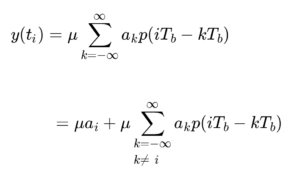InterSymbol Interference (ISI) is a kind of distortion that occurs when one or more symbols (pulses in digital baseband transmission) interfere with subsequent signals. This can cause noise in the signal which can cause the output to be less than ideal.
ISI occurs when there is multipath propagation and/or nonlinear frequency in the channels. These causes can be reduced which can help eliminate ISI from the system to achieve an ideal output.
Mathematical Form
The following equation mathematically represents the receiver output y(t) sampled at time t_i=i*T_b (with i representing integer values):
 The first term in the above equation, µ*a_i, is produced by the ith transmitted bit. The second term represents the residual effect or ISI of all other transmitted bits on the decoding of the ith bit. [1]
The first term in the above equation, µ*a_i, is produced by the ith transmitted bit. The second term represents the residual effect or ISI of all other transmitted bits on the decoding of the ith bit. [1]
Related Links
Research Gate Paper: ISI due to the atmospheric turbulence for FSO communication system
Harvard Paper: Differential phase-shift keying and channel equalization in FSO communication system
IEEE Paper: Conformal VLC receivers with photodetector arrays
